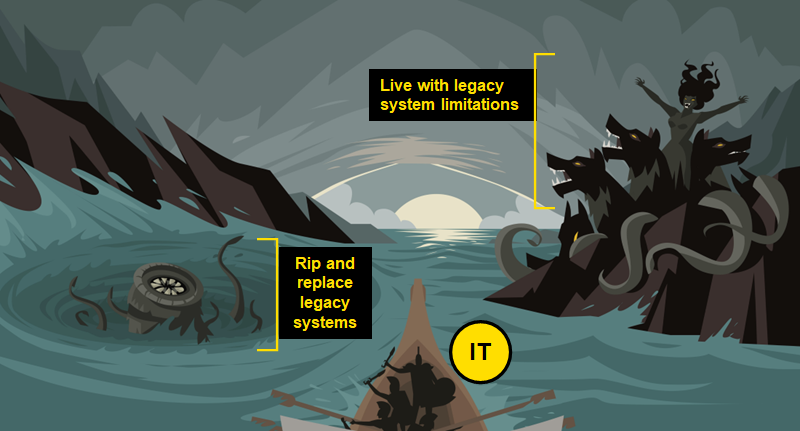Homer told a story of two sea monsters, Scylla and Charybdis, situated in a narrow strait. Sailors who passed through had to decide which peril to navigate: Risk the hungry six-headed Scylla on one side, or the whirlpool created by underwater Charybdis on the other side. This no-win situation is relatable to IT leaders dealing with legacy tech.
Your legacy operational systems were expensive to build. They have decades of business logic buried in them. Their long life means they have grown tentacles that reach across the enterprise. Though they power your business, their old age and outdated architecture also inhibit business innovation. They may be designed for batch, unable to keep up with modern workloads. You customized vendor software to death. No native support for REST inhibits their ability to deliver mobile UX. The list goes on and on.
Leaving them in place is unacceptable. But ripping and replacing them is unaffordable, particularly when they still delivery tremendous value for many use cases. What is an IT leader to do?

Integration: The Path Forward For Legacy Tech
There is a third way: integration. The right integration strategy can preserve your legacy tech investments where it makes sense, while extending legacy’s capabilities to keep pace with modern IT trends. The key pattern is to abstract away legacy applications. Then add behaviors by extending outside the legacy application rather than changing the application directly. To make this happen, you must start by designing business interfaces exposed via REST and event streams. Then, use integration tooling to orchestrate your legacy and modern systems into fulfilling the contract promises of these business interfaces. This removes application-specific dependencies and allows you to extend those interfaces with new behaviors – even if the new behavior comes from a new application outside your legacy app.
I recently interviewed several companies that have successfully transformed their legacy tech in this manner. Use cases included reducing the complexity of 30 ERPs, monthly outages due to an ancient ERP that couldn’t take real-time loads, and an inability to automate repair order processes in the field due to relying on a document management system with no APIs. In all these cases, integration architecture provided the companies a path forward to avoid the Scylla and Charybdis of legacy IT. Forrester clients can learn more about this trend by reading my recent report Leverage Integration Architecture To Resuscitate Legacy IT Systems. Or if you’re ready to deep dive into specific integration patterns and best practices, check out Breathe New Life Into Legacy Operational Systems With Integration Best Practices.








